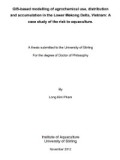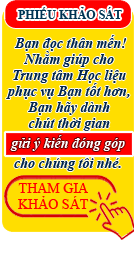


|
Tác giả: Phạm Kim Long. |
|
University of Stirling. Năm: 2012. Mô tả: 217Tr. Kích thước: 30cm. Số định danh: 639.8/ L431. Vị trí: Phòng Tài nguyên nội sinh. |
|
Abstract: In recent years, the Mekong delta has been strongly developed both for agr iculture and aquaculture. However, there is scope for a negative impact of agriculture on aquaculture in term of production and quality of seafood products. Specifically, the large amount of pesticides imported and used in the Mekong delta not only help agriculture purposes but can also easily enter aquatic systems and affect aquaculture. Pesticides can be transported in the environment by chemo-dynamic procedures and hydrological processes. As a result, pesticides used in agriculture become dispersed and their residues in sediment, water and biota have been detected in the Mekong delta. This study investigated the overall pesticide process including pesticide use, modelling pesticide accumulation and evaluating the potential impact on aquaculture sites for some target aquatic species. The risk of pesticides use in the Mekong delta was addressed in three stages: (1) investigating current pesticide use status in the Mekong delta; (2) modelling pesticide loss and accumulation; (3) classifying pesticide risk areas for aquaculture of target cultured species. A survey of 334 farms covering a total area of ~20,000km 2 in the Mekong delta took place between 2008 and 2009. Information on pesticide types and quantities was recorded using questionnaires, and it was found that 96 pesticides in 23 groups were popularly used for agricultural purposes. Dicarboximide, Carbamate and Conazole had the highest use at ~3000, ~2000 and ~2000 g/ha/year respectively. The survey revealed an increase in pesticide use per hectare since previous surveys in the Mekong delta in 1994, 2000, and 2004. However, the highly persistent compounds (WHO classification classes II, III and IV) appeared to have reduced in use. Insecticides previously represented >50% of the total pesticides used, however, the resent survey has shown their use has decreased to ~38%.There was a parallel increase in use of fungicides from previous levels of <30% of total pesticides to more recently ~41%. The combination of pesticide information and geolocation data enabled display and analysis of this data spatially using a Geographic Information System (GIS). A pesticide loss and accumulation model was established through combination of several sub-models including sediment loss and accumulation, direct loss, and water runoff, all of which were implemented and integrated within the GIS environment. MUSLE (Modified Universal Soil Loss Equation) was used to estimate sediment loss and accumulation in the Mekong delta and the Curve Number method (CN Method) was applied to predict water runoff and discharges and flow accumulation. Modelling commenced from the first pesticide application in April, based on 4 day time-steps. All mathematical calculations run within each time step automatically reiterated in the following time step with the new input datasets. The results from fuzzy classification of the pesticide model outcomes were considered in terms of the 96hr lethal concentration (LC50) in order to classify the risk and non-risk areas for catfish and tiger shrimp culture. The sediment loss and accumulation model shows that the highest loss of sediment was in the rainy season, especially in May to October. Vegetables and short term crop areas were found be most strongly eroded. The MUSLE model showed that the highest sediment accumulation was in the hilly areas (~1066.42 tonne/ha/year); lower in riverside areas (~230.39 tonne/ha/year) and lowest in flooded paddy areas (~150.15tonne/ha/year). Abamectin was used as an example throughout this study to estimate pesticide loss and its effects on aquaculture. The results showed that pesticide loss by runoff and sediment loss is less than the loss by half-life degradation (for Abamectin specifically). Accumulation of Abamectin occurred at highest rate in May and October and decreased with time. The spatial models showed that pesticide residues concentrated in the river and riverside areas. In order to evaluate the acute toxicity impacts, three levels of water depth in ponds were modelled as culture depths for catfish and tiger shrimp. The results show that the highest risk areas for catfish occurred in May and October with ~333,000 and ~420,000 ha at a pond depth of 0.5 m; ~136,000 and ~183,000 ha at a pond depth of 1.0 m; and ~10,840 and ~19,000 ha at a pond depth of 1.5 m. Risk areas for catfish mainly concentrated at the riverside and in part of the coastal areas. For tiger shrimp, the risk periods during the year were similar to those found for catfish. The highest risk areas for shrimp were ~648,000 and ~771,000 ha at 0.5 m pond depth; ~346,000 and ~446,700 ha at 1.0 m pond depth; and ~185,000 and ~250,000 ha at 1.5 m pond depth. Overall, deeper ponds reduced the risk. This study has developed a method to evaluate the negative impact of input pesticides to the environment from agricultural use related to fluctuation of aquaculture risk areas. The research indicates the potential relationship between pesticide input and the risk areas for aquaculture. The model has several significant uses: 1) it can provide information to policy makers for a more harmonized development of both aquaculture and agriculture in the Mekong delta in the future, 2) it provides data for aquaculture investment analysis to decrease the hazards caused by pesticide impacts, and 3) it provides a model capable of application to wide field scenarios and suitable for any pesticide type. |







